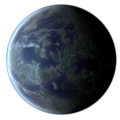Maridun (Planet)
| Maridun | |

| |
| Location | |
| System | Maridun |
| Sector | Rolion |
| Galactic Coordinates | (249, 253) |
| System Coordinates | (12, 6) |
| Astrographic Entry | Maridun |
| Statistics | |
| Type | temperate/breathable |
| Primary Terrain: | grassland |
| Rotational Period | |
| Orbital Period | |
| Population | 795,755 inhabitants |
| Control | |
| Controlled By | N/A |
| Governor | None |
| Magistrate | None |
| Sentient Races | Amani |
Homeworld of the Amani race, a dark prairie world situated between the Hydian Way and Perlemian Trade Routes in the Outer Rim Territories.
History
While Maridun's sun is unusually dim, the planet's Force aura is particularly bright. That is what attracted the Rakata, whose technology could detect and reach the planet because of its Force energy. Thus Maridun became one of the core realms of the Infinite Empire nearly 30,000 years ago. All traces of that despotic civilization have since disappeared, having been intentionally dismantled during the slave revolts.
With the collapse of the Infinite Empire, Maridun was mostly forgotten by the rest of the galaxy. The system went largely overlooked for the next 20,000 years until it was patrolled by Neo-Crusader scouts serving Mandalore the Ultimate. After the Battle of Malachor V, a few routed Mandalorians fled to Maridun seeking refuge from the Galactic Republic. But they did not develop a permanent colony. Just 300 years later, when Freia Kallea arrived seeking to connect the Morellian Trail and Spurs of Celanon, the planet was cataloged as being wild and uninhabited. It is thought that the abandonment of Maridun may have been due to the hostility of the native Amanin, the warlike race of headhunters who inhabit the forested regions.
As the Old Republic itself began to crumble, Lurmen, Hutts and other refugees and fugitives again began to arrive on Maridun seeking sanctuary from the conflict. This time, the settlers managed to achieve equilibrium with the Amani tribes and could live in relative peace by restricting their activity to the uncontested territories along the western shore of Maridun's largest ocean.
What began as a rough pioneer town has gradually transformed into an orderly, modern city with its own Star Tours terminal. Merchants, craftsmen, smugglers, and slavers all mingle profitably with the friendlier Amani tribes, who visit the city seeking to trade for technology.
Geology
Maridun is a terrestrial world that spins on a stable axis around its parent star. A bisected crust forms a fault line that runs along the center of the surface and turns roughly east in the northern hemisphere, pushing up three small mountainous regions. The two deepest depressions, located in opposite hemispheres, have filled with seawater. Without any moons or companion planets, the seas on Maridun are not tidal. The crust is thought to be rich in assorted ores, but prospecting teams are routinely attacked by Amani warbands and all expeditions to date have failed.
Climate
Maridun has a Type I breathable atmosphere that is composed of nitrogen, oxygen and hydrogen without any detectable contamination. The hydrosphere is quite modest, with some of the largest water sources being trapped underground and seeping out through springs. Most of these springs support the massive rainforests that have grown above them, although three have created small rivers and the largest of these feed the twin seas. These land-locked saltwater bodies drive much of the weather on Maridun, which is generally mild but because of the planet's gentle tilt, also seasonal. The magnetosphere is relatively weak for a planet of Maridun's size, but the solar wind is also much less intense. Because of the feeble solar glare and sparse cloud cover, Maridun's night skies are breathtaking and the brightest local stars are even visible during daylight hours.